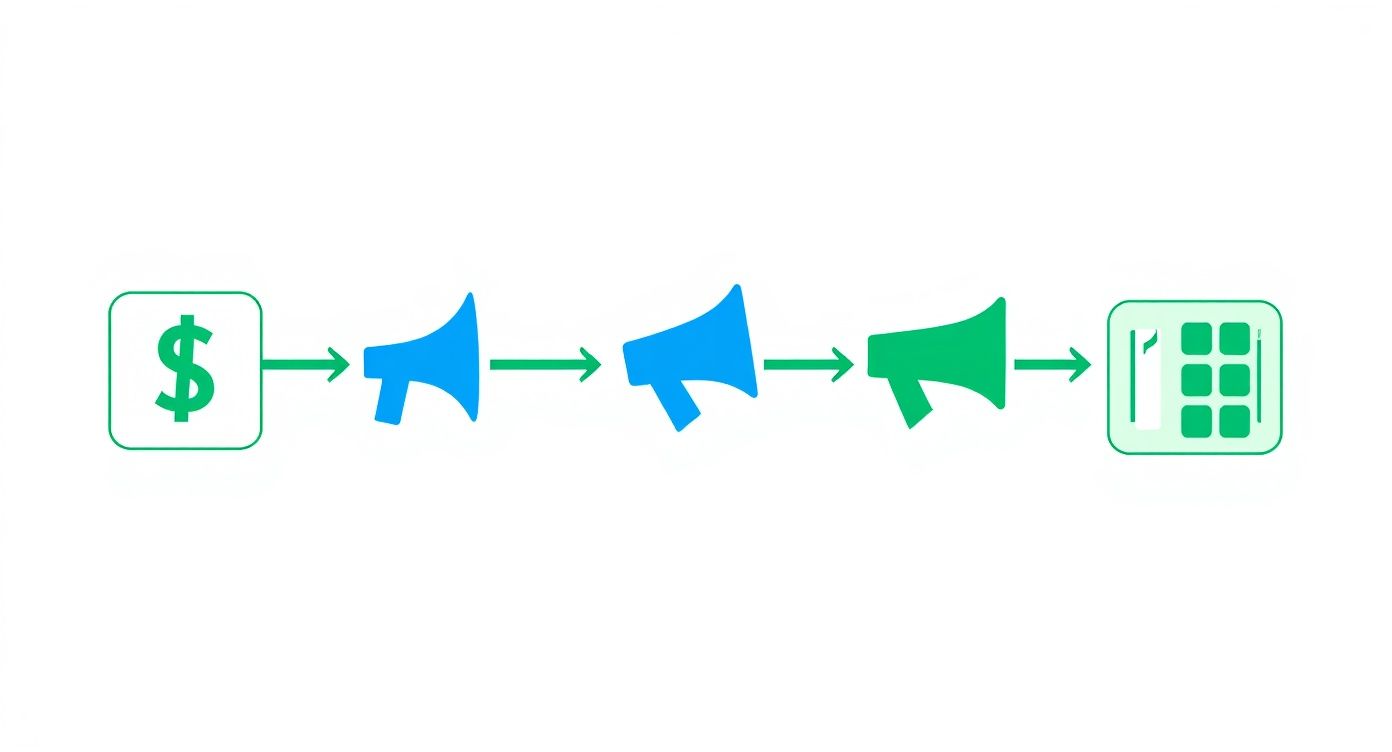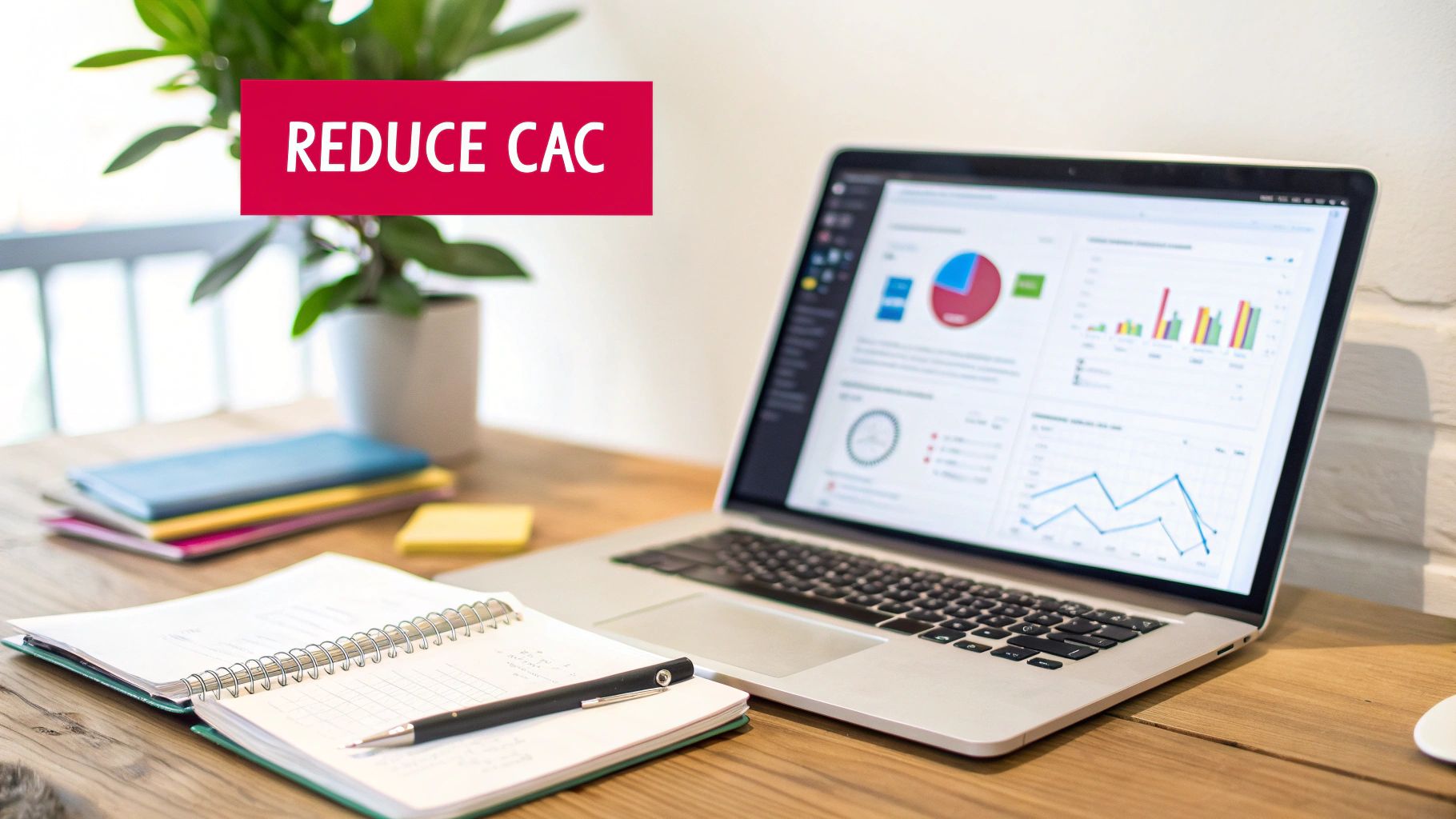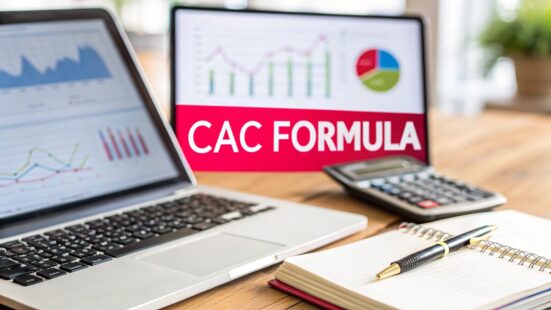 How to Find Influencers for Your Brand
How to Find Influencers for Your Brand
Calculating your customer acquisition cost is pretty straightforward on the surface. You just divide your total sales and marketing expenses over a set period by the number of new customers you won in that same timeframe.
But that simple formula hides a powerful truth: this single metric tells you exactly how much you're spending to get each new customer in the door. Getting this calculation right is the bedrock of sustainable growth and smart budgeting.
Table of Contents
Why Mastering Your CAC Calculation Is Non-Negotiable

Before we jump into the formula's nuts and bolts, let's be clear about why your Customer Acquisition Cost (CAC) is so much more than another number on a spreadsheet.
Think of it as the pulse of your business's financial health. It’s the diagnostic tool that shows whether your growth engine is purring along efficiently or just burning through cash with nothing to show for it.
An accurate CAC is your clearest path to profitability. It shines a spotlight on your high-performing marketing channels and exposes the ones that are quietly draining your bank account. Without that clarity, you're flying blind, throwing money at campaigns and just hoping for the best.
The Rising Cost of Acquiring Customers
Let's face it—getting new customers is harder and more expensive than ever. The market is crowded, and ad channels are completely saturated.
The data doesn't lie. The average customer acquisition cost has shot up by a staggering 222% between 2013 and 2025. Back in 2013, businesses were losing about $9 per new customer. By 2025, that loss is expected to hit an average of $29. That trend alone should tell you how urgent it is to get a precise handle on your spending. You can dig into the full breakdown of these customer acquisition cost statistics for more detail.
This massive jump means that ignoring or miscalculating your CAC isn't a small mistake—it's a direct threat to your company's survival.
How CAC Informs Strategic Decisions
Once you truly understand your acquisition cost, you can start making smarter, data-backed decisions that impact your entire business. It gives you the confidence to justify marketing spend, move resources where they'll have the biggest impact, and build a growth model that can actually last.
Here’s how a firm grasp on your CAC changes the game:
- Smarter Budget Allocation: You'll finally see which channels—paid search, social media, content marketing—are giving you the best bang for your buck. This lets you double down on what’s working and cut the dead weight.
- Informed Pricing Strategy: Your CAC is directly tied to your pricing. If it costs you $150 to acquire a customer, your pricing has to be high enough to cover that cost and still generate a healthy profit over that customer's lifetime.
- Investor Confidence: For any startup or growing company looking for funding, a well-documented and optimized CAC is proof of a viable business model. It tells potential investors that you know your unit economics inside and out.
Here's a pro tip: A low CAC isn't always the main goal. A high CAC can be perfectly fine if you're bringing in high-value customers with a massive lifetime value. The real key is knowing your number and how it stacks up against what that customer is worth to you over time.
Ultimately, calculating your CAC isn't just about tallying up past expenses. It’s a forward-looking metric that lays the groundwork for profitable, long-term success. It gives you the core insight you need to fine-tune your entire growth strategy.
Tracking the Right Costs for an Accurate CAC Formula
Calculating your Customer Acquisition Cost feels straightforward on the surface, but a truly accurate number depends entirely on what you feed into the formula. If you're only counting obvious expenses like ad spend, you're flying blind with a dangerously incomplete picture of your real costs.
To get this right, you have to dig into every single dollar spent on winning a new customer. This isn't just about surface-level numbers; it's about a comprehensive audit of all marketing and sales expenses within a specific timeframe. You really have to leave no stone unturned.
Let's break down the two main cost centers you need to get granular with: sales and marketing.
Tallying Up Your Sales Costs
Sales costs go way beyond just salaries. For a proper customer acquisition cost calculation, you need to account for everything that helps your sales team actually close deals. Think of it as the total investment in your revenue engine.
I always recommend starting with the big-ticket items and then working your way down to the smaller, often-forgotten expenses.
- Salaries and Commissions: This is the base pay for everyone on the sales team, from reps to managers. Critically, you also need to loop in all commissions, bonuses, and any performance incentives paid out during the period you're measuring.
- Sales Tools and Software: What does your team use day in and day out? This includes your CRM subscription (like Salesforce or HubSpot), any lead generation platforms, sales intelligence tools, and software for scheduling demos or managing contracts.
- Overhead and Operational Costs: A slice of your general overhead has to be attributed to the sales team. This could be a percentage of the rent for their office space, utilities, and other administrative costs that support them. Don't forget travel and entertainment for client meetings or industry events, either.
A classic mistake I see all the time is forgetting to prorate annual software subscriptions. If you pay $12,000 for a CRM for the year but are calculating a quarterly CAC, you should only include $3,000 of that cost in your formula.
Identifying All Marketing Expenses
Marketing costs can get even more complex, with dozens of different channels and tools all adding up. This is where hidden costs love to hide, completely derailing an accurate CAC calculation. The goal here is to capture every expense tied to building brand awareness and handing qualified leads over to sales.
For a deeper look into the mechanics, you can check out this guide on the Customer Acquisition Cost formula. But for now, here’s a quick-and-dirty checklist to make sure you’re not missing anything.
- Ad Spend: This is the most direct cost. Tally up every dollar spent on platforms like Google Ads, Meta (Facebook/Instagram), LinkedIn Ads, TikTok, and any other paid media channel you're using.
- Salaries for Marketing Staff: This covers your entire marketing team—content creators, SEO specialists, social media managers, and strategists.
- Content Creation Costs: Did you hire freelance writers, videographers, or graphic designers? These external costs are a direct part of your acquisition efforts and absolutely must be included.
- Marketing Technology Stack: Make a list of all your marketing software subscriptions. This means email marketing platforms (like Mailchimp), SEO tools (like Ahrefs or Semrush), analytics software, and marketing automation platforms.
This level of detail is non-negotiable. While this section is all about finding the right costs, you can also check out our guide on how to calculate cost per acquisition for a step-by-step on the formula itself.
To make sure nothing slips through the cracks, I've put together a checklist that breaks down the most common expenses you should be tracking.
Comprehensive Checklist of Costs to Include in CAC
Use this table as your guide to ensure you're capturing a full 360-degree view of your acquisition spending. A detailed approach prevents nasty surprises and gives you a CAC number you can actually trust for strategic decisions.
| Cost Category | Specific Examples | Notes for Tracking |
|---|---|---|
| Sales Salaries & Commissions | Base salaries, commissions, bonuses, performance incentives for sales reps and managers. | Track this monthly from your payroll system. Ensure you're using gross pay. |
| Marketing Salaries | Salaries for content creators, SEO specialists, social media managers, marketing VPs. | Just like sales, pull this directly from payroll for the specified period. |
| Paid Advertising | Spend on Google Ads, Meta Ads, LinkedIn Ads, TikTok Ads, print, and other paid media. | Export reports directly from each ad platform for the exact date range. |
| Software & Tools (MarTech/SalesTech) | CRM (HubSpot, Salesforce), SEO tools (Ahrefs), Email (Mailchimp), Analytics. | Prorate annual subscriptions. If you pay $1,200/year, use $100 for monthly CAC. |
| Content Creation Expenses | Freelance writers, graphic designers, videographers, stock photo subscriptions. | Keep a running tab of all contractor invoices and content-related purchases. |
| Events & Travel | Booth fees for trade shows, travel/accommodation for sales/marketing, client dinners. | Meticulously log all receipts and expenses related to acquisition-focused events. |
| Overhead Allocation | A percentage of rent, utilities, and office supplies attributed to sales/marketing teams. | Work with your finance team to determine a fair percentage to allocate. |
By diligently logging every sales and marketing cost using a checklist like this, you build a reliable foundation. A small business might do this in a detailed spreadsheet, while a larger company will use accounting software. The tool you use isn't as important as the discipline you bring to the process. An accurate CAC formula is a true reflection of your business's health.
Putting the CAC Formula to Work With Real Examples
Okay, you've done the hard work of gathering your costs and counting up your new customers. Now for the fun part: plugging those numbers into the customer acquisition cost calculation and seeing what story they tell. The formula itself—Total Sales & Marketing Costs / New Customers Acquired—looks simple on paper. But its real power comes alive when you apply it to actual business scenarios. Let's walk through a couple of examples.
This visual gives you a great overview of how all those different sales and marketing expenses funnel down into one final CAC number.

The big takeaway here is that you absolutely have to combine both cost centers. A siloed view gives you a skewed number; a fully-loaded CAC is the only way to get an honest look at your spending.
Calculating a Simple Quarterly CAC for a SaaS Business
Imagine you're running a SaaS company called "SyncUp," a project management tool. It's time for your Q1 business review, and you need to calculate your CAC for the quarter. This is the perfect high-level metric for board meetings and investor updates.
First things first, you need to pull together all your costs for Q1 (that’s January, February, and March).
- Total Sales Costs: This would be salaries for your three sales reps, commissions they earned, and the subscription cost for your CRM. Let’s say that all adds up to $75,000.
- Total Marketing Costs: Here, you'll include your marketing manager's salary, your ad spend across LinkedIn and Google, plus the fees for your SEO tools. We'll put this at $50,000.
Your Total Acquisition Spend for the quarter is simply $75,000 + $50,000 = $125,000.
Over that same three-month period, the team hustled and brought in 250 new paying customers.
Now, we just pop those numbers into the formula:
$125,000 / 250 New Customers = $500 CAC
There it is. For every new company that signed up for SyncUp in Q1, it cost you $500. This number is your new baseline—a vital benchmark you'll use to measure performance and validate your business model moving forward.
Digging Deeper with a Channel-Specific CAC Calculation
A blended, company-wide CAC is a great starting point, but it hides a lot of important details. It doesn't tell you which channels are actually driving efficient growth. The real magic happens when you start segmenting your CAC by marketing channel. This is how you discover if your Google Ads are outperforming your Meta campaigns, or vice-versa.
Let's switch over to an e-commerce brand, "Glow Naturals," which sells organic skincare. For the month of June, they want a head-to-head comparison of their CAC from two main channels: Meta Ads (Instagram and Facebook) and Google Ads.
To pull this off, they have to carefully isolate the costs and attribute new customers to each specific channel.
Analyzing the Meta Ads Campaign
The team at Glow Naturals needs to tally up every single dollar spent on their Meta advertising efforts in June.
- Direct Ad Spend: They spent exactly $8,000 on their ad campaigns across Instagram and Facebook.
- Creative Costs: A freelance designer was paid $500 to create the visuals for the June ads.
- Team Time (Prorated Salary): Their social media manager dedicates about half her time to paid social. With a monthly salary of $5,000, they’ll attribute $2,500 of that cost to the channel.
The Total Meta Ads Cost for June comes out to $8,000 + $500 + $2,500 = $11,000.
Using their analytics software, they tracked that these campaigns were directly responsible for bringing in 440 new customers.
Meta Ads CAC = $11,000 / 440 Customers = $25
Assessing the Google Ads Performance
Next, they do the exact same exercise for their Google Ads campaigns.
- Direct Ad Spend: The budget for Google Search ads in June was $10,000.
- Agency Fees: They pay a digital marketing agency a $2,000 monthly retainer to manage these campaigns.
- Team Time (Prorated Salary): The marketing director spends roughly 10% of her time on Google Ads strategy. Her $7,000 monthly salary means they attribute $700 here.
So, the Total Google Ads Cost for the month is $10,000 + $2,000 + $700 = $12,700.
Their tracking shows that these Google campaigns delivered 385 new customers.
Google Ads CAC = $12,700 / 385 Customers = $32.98
The results are now staring them right in the face. For Glow Naturals, acquiring a customer through Meta Ads ($25) is significantly cheaper than through Google Ads ($32.98). This kind of granular insight is pure gold.
It doesn't necessarily mean they should kill their Google Ads budget tomorrow. But it does give them a clear signal to investigate why that channel is more expensive and start thinking about reallocating their budget for maximum impact. This is what a proper customer acquisition cost calculation is all about—driving smarter, more profitable decisions.
What Your CAC Is Really Telling You
Calculating your Customer Acquisition Cost is a huge first step, but that number on its own—whether it's $50 or $500—doesn't tell you much. In fact, a raw CAC figure is pretty much useless without its better half: Customer Lifetime Value (LTV). A high CAC might be a disaster for one company but a massive win for another. It all comes down to context.
The real magic happens when you use that customer acquisition cost calculation to ask deeper questions about your business's long-term health. Think of it as the starting pistol for a race toward profitability and sustainable growth.
The Power Couple of Growth Metrics: LTV and CAC
It’s a simple concept, really. CAC is what you spend to get a customer, and LTV is what you get back from them over time.
Customer Lifetime Value is the total revenue you can realistically expect from a single customer throughout their entire relationship with your brand. When you put these two metrics side-by-side, you finally get a clear picture of whether your acquisition strategy is actually working.
Figuring out LTV can get complicated, but a straightforward formula works for most businesses.
- Average Purchase Value: Your total revenue in a period divided by the number of purchases.
- Average Purchase Frequency: The number of purchases divided by the number of unique customers.
- Customer Value: Multiply your average purchase value by your average purchase frequency.
- Average Customer Lifespan: How long does a customer typically stick around and keep buying?
- And finally, LTV: Multiply the customer value by the average customer lifespan.
Once you have both LTV and CAC, you can calculate the LTV to CAC ratio. This simple division is arguably the single most important metric for understanding if your business model has legs.
LTV to CAC Ratio = LTV / CAC
This ratio tells you exactly how many dollars you get back for every dollar you sink into finding a new customer. It's the ultimate health check for your marketing and sales engine.
Decoding Your LTV to CAC Ratio
Your LTV to CAC ratio isn't just a number; it's a signal telling you whether to hit the brakes or slam on the accelerator. Most experts agree that the gold standard for a healthy, growing business is a ratio of 3:1. This means for every $1 you spend on acquisition, you’re bringing in $3 in lifetime value. It's the sweet spot—you're acquiring customers profitably while leaving plenty of room to cover all your other costs.
But what about other ratios?
- A 1:1 Ratio: This is a five-alarm fire. You’re spending $1 to make $1 back… eventually. After you pay for salaries, rent, and everything else, you're losing money on every single customer. This is a fast track to burning cash.
- A 5:1 Ratio (or higher): Looks amazing, right? But it often means you're being too conservative. You've built an incredibly efficient acquisition machine, but you’re probably leaving a ton of money on the table by not investing more aggressively to capture a bigger piece of the market.
Let’s look at a real-world example. Say an e-commerce brand has a CAC of $50.
- Scenario A: Their LTV is $75. The LTV/CAC ratio is a shaky 1.5:1. They're technically making money, but the margin for error is razor-thin.
- Scenario B: Their LTV is $150. The LTV/CAC ratio is a solid 3:1. This is a healthy, scalable model. They can confidently reinvest in what's working.
- Scenario C: Their LTV is $300. The LTV/CAC ratio is an incredible 6:1. They're wildly profitable and should probably be pouring more fuel on the fire to grow even faster.
Of course, this all hinges on knowing which channels are bringing in your best customers. To get granular, you have to understand the customer journey and learn more about what is attribution modeling to properly credit your marketing efforts.
Using the Ratio to Drive Strategic Shifts
This ratio should be one of the main drivers of your business strategy, influencing everything from your marketing budget to your product roadmap.
A low LTV to CAC ratio is a call to action. It forces you to look critically at either reducing your acquisition costs or increasing the value you get from each customer—or both.
Here’s how this one number can guide your decisions:
- Marketing Strategy: Is your ratio low, like 1.5:1? It might be time to pull back on expensive paid ads and lean into more cost-effective channels like SEO or content marketing. If it’s high (5:1 or more), that’s a green light to double down on your best-performing campaigns.
- Pricing and Product Strategy: A low ratio could be a sign that your prices are simply too low to support your acquisition efforts. Maybe it’s time to rethink your pricing tiers, introduce premium add-ons, or find other ways to increase the Average Revenue Per User (ARPU).
- Retention Efforts: Boosting customer retention is one of the quickest ways to pump up your LTV. If your ratio is looking unhealthy, investing in customer success, loyalty programs, or simply improving the user experience can pay off big time by keeping customers around longer.
At the end of the day, the customer acquisition cost calculation gives you one half of a critical story. It’s only when you pair it with LTV that you get the full picture you need to build a business that’s not just growing, but built to last.
Practical Strategies to Lower Your Acquisition Cost

Alright, you've done the math and you know your customer acquisition cost. The numbers are on the board. Now for the real work: making that number smaller.
Bringing your CAC down is one of the fastest tracks to better profitability, and it doesn't require a complete business overhaul. It’s all about working smarter with the traffic and customers you already have.
Let's get into some proven strategies that can actually move the needle.
Enhance Your Conversion Rate Optimization
If you want the biggest bang for your buck, start with Conversion Rate Optimization (CRO). It's the most powerful lever you can pull. Just think—if you double your conversion rate from the same amount of traffic, you've literally just cut your CAC in half.
The beauty of CRO is that big wins often come from small, iterative tweaks, not massive budget increases.
Start by walking through your entire conversion funnel. Pinpoint exactly where people are dropping off.
- A/B Test Your Landing Pages: Don't get attached to your designs. Constantly test your headlines, CTAs, hero images, and even the length of your forms. I've seen a simple button color change lift conversions by double-digit percentages. It happens.
- Simplify Your Checkout Flow: Every single field you ask someone to fill out is another reason for them to leave. Is that "How did you hear about us?" dropdown really worth losing sales over? Remove unnecessary steps, offer guest checkout, and be brutally transparent with shipping costs upfront. Unexpected fees are the number one killer of conversions.
Leverage Your Existing Customer Base
Your happiest customers are, hands down, your best and cheapest marketing channel. The old saying is true: acquiring a new customer is anywhere from 5 to 25 times more expensive than keeping an existing one. When you focus on retention and referrals, your customers become your growth engine.
This is where your budget strategy really comes into play. To get the most out of your spend, a smart digital marketing budget allocation that prioritizes high-ROI activities like this is critical.
Key Takeaway: A well-structured referral program will almost always have a lower CAC than any paid ad channel. You’re simply rewarding your current customers for bringing you warm leads who are already primed to trust you.
Set up a simple, rewarding referral program. Make it ridiculously easy for people to share and give both the referrer and their friend a compelling reason to participate. This creates a powerful, low-cost acquisition loop that can sustain itself.
Double Down on Content and SEO
Paid ads get you results today. But the costs are always rising.
Content marketing and SEO, on the other hand, are long-term assets. You're building a foundation for consistent, low-cost, organic customer acquisition. It's a strategy that pays dividends for years.
When you create genuinely helpful content that solves your audience's problems, two amazing things happen:
- It Builds Trust: You become the go-to authority in your space, warming up potential customers long before they're ready to buy.
- It Drives Organic Traffic: A single, high-quality blog post or guide can rank on Google for years, bringing in a steady flow of qualified visitors with zero ongoing ad spend.
This approach methodically lowers your blended CAC over time. While you might still use paid ads for a quick boost, your organic channels become the reliable, cost-efficient engine driving your growth.
Choosing the right mix of these strategies depends on your business model and timeline. Paid channels are fast but expensive; organic channels are slower but build long-term, low-cost momentum.
Comparing High-CAC vs. Low-CAC Acquisition Strategies
Not all acquisition channels are created equal. Some offer immediate but costly results, while others are a slow burn that pays off in the long run. Here's a quick comparison to help you think about where to allocate your resources.
| Strategy | Typical CAC Impact | Time to See Results | Best For |
|---|---|---|---|
| Paid Ads (PPC/Social) | High | Immediate | Quick lead generation, testing offers, short-term campaigns |
| Influencer Marketing | Medium to High | Weeks to Months | Building brand credibility and reaching niche audiences |
| Content & SEO | Low (over time) | 6+ Months | Sustainable, long-term growth and building brand authority |
| Referral Programs | Very Low | Immediate | Leveraging existing customer base for cost-effective growth |
| Email Marketing | Very Low | Immediate | Nurturing leads and driving repeat purchases from existing customers |
Ultimately, the goal isn't to rely on just one channel. The most resilient businesses build a diversified acquisition portfolio. They use higher-CAC channels for immediate feedback and growth while investing in lower-CAC channels to create a sustainable, profitable future. By focusing on CRO, activating your customer base, and building organic assets, you can systematically reduce your reliance on expensive channels and build a much stronger business.
Getting Granular: Answering Your Top CAC Questions
Even once you've got the basic CAC formula down, things can get a little fuzzy when you start applying it to your actual business. I've seen a lot of companies trip over the same few details. Let's clear up the most common sticking points so you can calculate your CAC with confidence.
One of the first questions that always comes up is about salaries. What do you do with team members who only spend some of their time on acquisition? Simple: you prorate their salary. If a marketing manager dedicates 25% of their time to running campaigns that bring in new leads, then 25% of their salary for that period goes into your total costs. You absolutely have to include this for an accurate number.
Another gray area is separating acquisition from retention. What about that email campaign you sent to your existing customers? Nope, that doesn't count. CAC is all about the cost to get new customers in the door. Keep your retention-focused expenses separate to avoid muddying the waters.
What's the Deal with Freemium Users?
This is a big one for SaaS companies or any business with a freemium model. Do you count a new free sign-up as an "acquired customer"? The answer is a hard no. For the purpose of customer acquisition cost, a customer is someone who pays you.
Here’s how to handle it: all the marketing and sales spend that attracts both your free and paid users goes into the "costs" bucket. However, only the users who convert to a paid plan go into the "new customers" bucket. This gives you the true cost to acquire a paying customer.
It's tempting to count free users—it makes your CAC look amazing! But that's just vanity. Including them would inflate your customer count and create a misleadingly low CAC, making your acquisition efforts seem way more efficient than they really are.
CAC vs. CPA: Know The Difference
People throw these two terms around like they're the same thing, but they measure fundamentally different things. Mixing them up can lead to some serious confusion in your reporting.
Let’s break it down:
- CAC (Customer Acquisition Cost) is the big-picture metric. It tells you the total cost to acquire a brand new, paying customer. Think of it as the final score.
- CPA (Cost Per Acquisition) is more tactical. It measures the cost of a specific action or conversion, which might just be a step on the way to a sale. This could be a lead, a free trial sign-up, or an app download.
For example, your CPA to get someone to register for a webinar might be $15. But if only a fraction of those attendees become paying customers, your actual CAC could be closer to $300. For a deeper dive into metrics like these, it's worth exploring the nuances of Cost Per Acquisition (CPA) on Amazon, which is a close cousin to CAC.
At JoinBrands, we connect you with over 250,000 creators to produce authentic UGC that drives down acquisition costs and boosts sales. Start your campaign today!








